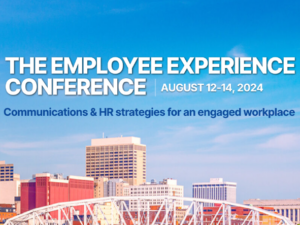How data can unearth what your employees really think
Surveys and check-ins offer important but limiting insight into your workforce. Use the data from communication platforms to get a full picture of how your employees really feel.

Employee burnout, stress and engagement is top of mind to every communicator.
Pulse surveys and check-ins are helpful tools to determine how your employees think and feel about a range of issues going on in the world today, and how your organization is responding to them.
While important, those methods tell part of the story.
“In those situations, you’re only going to be able to get the insights that employees are willing to share with you point blank,” says Betsy Sewell, head of marketing at Aware, a company that analyzes the data from Microsoft Teams, Yammer, Slack, and Workplace from Facebook.
Those platforms are intended to help employees communicate and collaborate digitally—critical for remote workforces—but offer areas where employees can chat based on interest groups, for instance.
“It’s where these employees now are going to have their water cooler conversations,” Sewell says
By having those conversations in digital form, there’s a wealth of data at your fingertips to derive insights. “Every day you can plug in and see how things are trending. It allows the data points to drive decisions making rather than gut or anecdotes,” she says.
You can learn what topics are being talked about most, popular themes and the sentiment of the conversations around those themes.
“Remote work might be a top theme, but are people talking about it in a positive way, that they enjoy working from home? Or are they talking about it in negative way and they’re frustrated with their kids screaming in one room and their spouse in another, and they can’t get any work done.”
Data can measure overall conversation health and sentiment on the organizational level (Is overall conversation sentiment above or below average? Does something need to be addressed?) as well as drill down to a specific group in Teams to address what topics are important to that group and what their sentiment is.
For example, one organization knew conversations about the Black Lives Matter Movement were happening on its communications platform. It used the data in many ways, including determining if the conversations were healthy or in need of moderating, as well as tapping into how employees were responding to corporate announcements and initiatives—were they satisfied or was there still room for improvement? The data also showed how many employees were openly admitting they had privilege or experienced injustice.
“That has really helped them to make some informed decisions around not just where they invest their dollars from a social movement perspective,” Sewell says, “but also allowed them to really dig in and understand if there’s a culture change that needs to happen at the organization and where’s the root of that change.”
Data analysis can also spot violations of acceptable use policies.
It helps communicators, often tasked with moderating these groups, to understand where conversations are happening—in a chat, private Teams group, or Slack channel—and where some violations are occurring. You can then set the system up to send automated messages. For example, notifying an employee automatically of unacceptable language: “It’s against policy to use discriminatory language, see XYZ for further training.”
“There could be some conversations that aren’t aligning with culture happening that you may not know about and oftentimes individuals who might be on the receiving end of these conversations don’t feel necessary compelled to report them,” Sewell says.
Learn more ways to use data to drive decisions during Sewell’s upcoming session at Ragan’s Remote Employee Engagement & Culture Virtual Conference on July 21.
This article is in partnership with Aware.







